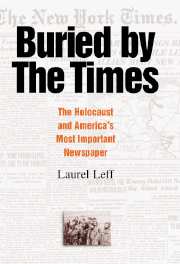Book contents
- Frontmatter
- Dedication
- Contents
- Acknowledgments
- Note Abbreviations
- Introduction: “Last Voice from the Abyss”
- PART I 1933—1941
- 1 “Not a Jewish Problem”: The Publisher's Perspective on the Nazis' Rise and the Refugee Crisis
- 2 “This Here Is Germany”: Reporting from the Berlin Bureau
- 3 “Worthy of France”: The Vichy Government's Anti-Semitic Laws and Concentration Camps
- 4 “A New Life in Nazi-Built Ghettos”: German Domination of Poland, Rumania, and the Baltic States
- PART II 1942—1945
- Conclusion: “The Horrible Story Was Not Told”
- Appendix A Key Individuals
- Appendix B Key Institutions
- Appendix C List of Front-Page Stories
- Notes
- Index
1 - “Not a Jewish Problem”: The Publisher's Perspective on the Nazis' Rise and the Refugee Crisis
Published online by Cambridge University Press: 05 February 2015
- Frontmatter
- Dedication
- Contents
- Acknowledgments
- Note Abbreviations
- Introduction: “Last Voice from the Abyss”
- PART I 1933—1941
- 1 “Not a Jewish Problem”: The Publisher's Perspective on the Nazis' Rise and the Refugee Crisis
- 2 “This Here Is Germany”: Reporting from the Berlin Bureau
- 3 “Worthy of France”: The Vichy Government's Anti-Semitic Laws and Concentration Camps
- 4 “A New Life in Nazi-Built Ghettos”: German Domination of Poland, Rumania, and the Baltic States
- PART II 1942—1945
- Conclusion: “The Horrible Story Was Not Told”
- Appendix A Key Individuals
- Appendix B Key Institutions
- Appendix C List of Front-Page Stories
- Notes
- Index
Summary
Sitting in his office on 43rd Street in November 1939, New York Times Managing Editor Edwin L. James knew that the letter on his desk raised a charged but peripheral issue. A reader had written wanting to know why the Times had not carried a particular report from the Jewish Telegraphic Agency (JTA), a wire service for Jewish news. The JTA had reported from newly occupied Poland that the Germans were demanding that a Jewish council in Lodz provide its soldiers with “100 young Jewish girls, the object being to quench their desires.” James understood Europe as well as anyone at the Times, having covered what would now be called the First World War and having remained on the continent for the following 13 years. So he knew the report was not important in terms of the almost 3-month-old world war: the Germans had easily subdued Poland weeks ago. It was not even central to the emerging picture of what was happening to the Jews there. The main story, as the Times reported it, was the deportation of thousands of Jews from Czechoslovakia, Austria, and Germany to a “reservation” near Lublin. But given the subject and knowing his boss, James believed he had better run the JTA report past him.
James' boss was Arthur Hays Sulzberger, the Times' publisher and representative of the family that had owned the newspaper for four decades.
- Type
- Chapter
- Information
- Buried by the TimesThe Holocaust and America's Most Important Newspaper, pp. 19 - 48Publisher: Cambridge University PressPrint publication year: 2005



